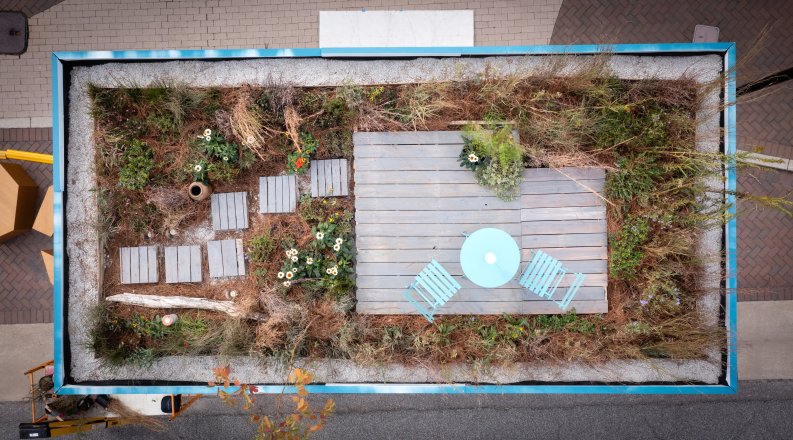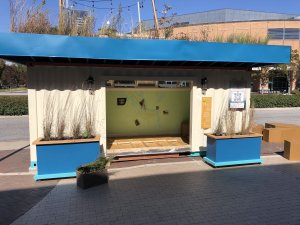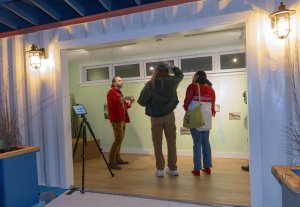By Jonah Grinkewitz
A new art exhibition at Old Dominion University invites Hampton Roads residents to share their experiences with the region’s waterways and its changing environment through audio recordings, images and writings.
“Soundings: Sound Map for a Changing Landscape,” an immersive art installation consisting of a 20-foot shipping container with a green roof made up of native plants, will be on display outside the Barry Art Museum on ODU’s campus through Oct. 20 during museum hours. The exhibition made its debut this past weekend at the University’s fourth annual public arts festival.
The socially engaged art project was created by ODU Associate Professor of Art Brendan Baylor and his collaborator, Kelly Morse, a landscape designer and former ODU literature instructor who runs 70|30 Design Studio. The installation is also a culmination of ODU’s previous Annual Campus Theme “Blue Connections.”
The container itself was donated by CHS Container Group where ODU alum Edward “Ed” Shea works. Carroll Transportation Group, where fellow alum Andrew Smith is an employee, donated their time and resources to move the container. Both are members of ODU’s chapter of the Propeller Club, a nonprofit professional organization that supports the national maritime community and promotes waterborne commerce.
Plants for the roof were provided by Southern Branch Nursery and Lady Fern’s Native Plants, local woman-owned companies.
The installation draws upon the specialties of both collaborators. The inside of the container features prints made by Baylor, who teaches printmaking at the University, and audio recordings of interviews and natural sound played through speakers. On top of the structure Morse designed and installed a working “green roof” composed of a waterproof membrane, drainage layer, soil and plants native to southeast Virginia.
Baylor captured the initial recordings, but the goal is to have Hampton Roads residents contribute directly to the exhibition with their own stories and memories of how the landscape they live in has changed over their lifetime. People who wish to participate can upload their images, writings or audio files to the art project’s website and pin their location on the digital map.
“We’re really interested in thinking about the way the land is changing not just from a big picture perspective or from an expert perspective but also from everyday people,” Baylor said. “That’s the kind of experience we don’t typically include when we’re thinking about policy and climate change.”
Morse’s green roof serves as an example of how to add habitat to urban areas. Her studio’s name – 70|30 – is inspired by research that suggests songbirds thrive in areas where at least 70% of the plants are native.
“My design philosophy centers on creative ways to add nature to human-centered spaces,” Morse said.
Many U.S. and international cities now have policies for building green roofs onto any new commercial structures, Morse noted. Chicago, Toronto, Baltimore, and Portland, Oregon are just a few North American cities that offer grants to homeowners to retrofit green roofs onto their properties.
“Green roofs can absorb up to 75% of water that falls on them in a year. Imagine how much flooding would be reduced if this solution is systematically added to our region,” Morse said. “Instead of having stormwater be a problem, it could benefit pollinators and birds by sustaining what’s called ‘steppingstone habitats’ through cities.”
Baylor said much of his and Morse’s art – including this project – was inspired by the indigenous botanist and author Robin Wall Kimmerer whose work combines Western scientific thought and Native American cultural practices.
“The main inspiration for the work is reciprocity and building a culture of reciprocity where our relationships with each other and with the landscape are more about mutual support and thriving rather than an extractive, transactional relationship,” he said.
“This project succeeded because of the relationships we’ve developed in the Hampton Roads community,” Morse added.
After its run at ODU, Baylor said he hopes the installation will travel to other cultural institutions to be displayed – a feat made easier by it being a shipping container. And since the digital map is global, people anywhere can upload to the project. Long term, the installation will reside in Baylor and Morse’s backyard as an art studio.
To learn more about Baylor and his artwork, you can visit his website.





